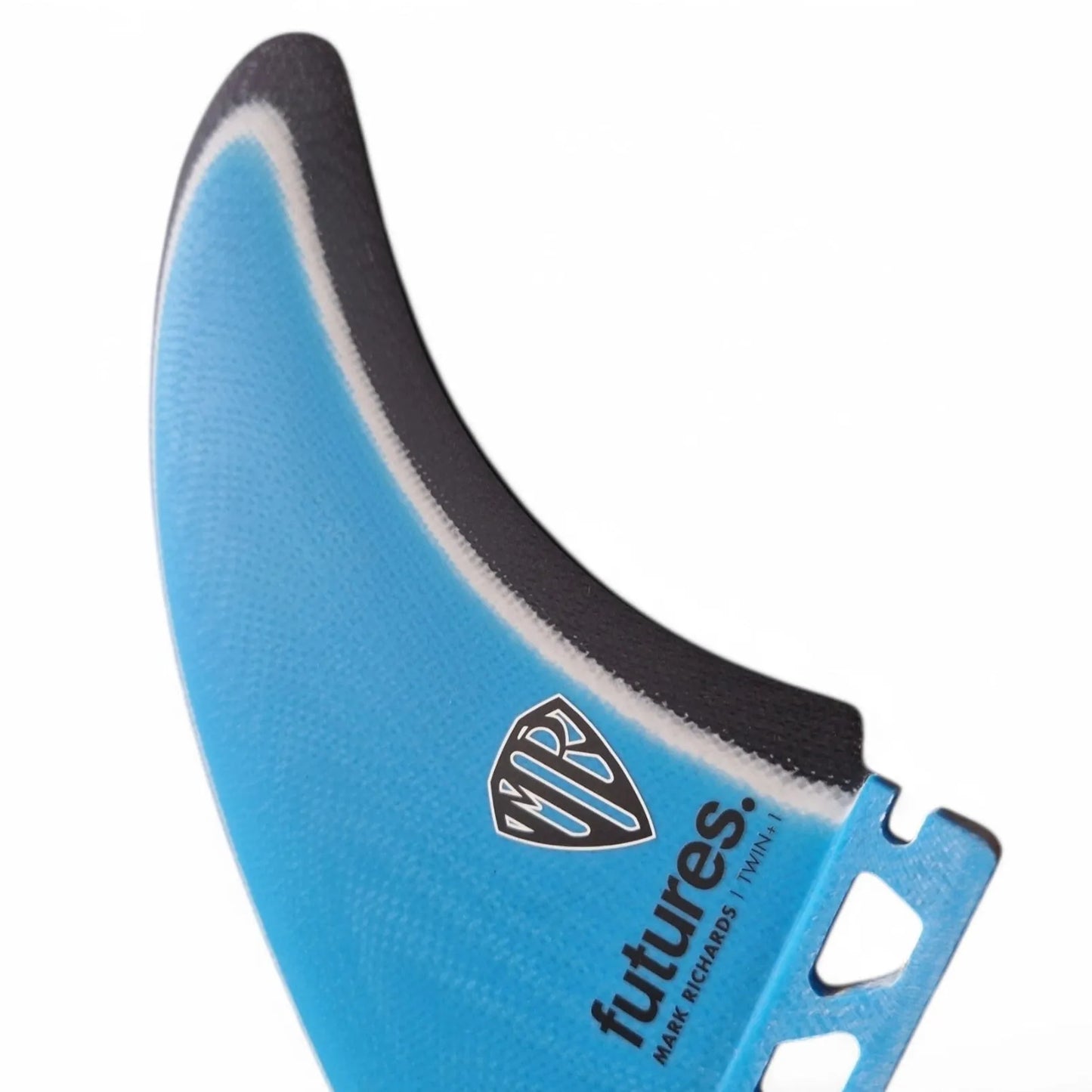Futures MR Mark Richards Twin +1 Trailer Surfboard Fins
Futures MR Mark Richards Twin +1 Trailer Surfboard Fins
In stock
Couldn't load pickup availability
Futures MR Mark Richards Twin +1 Trailer Surfboard Fins
The MR Twin+ 1 set combines the best performance features of a twin fin and a thruster. Pure twin surfboard fins are fast, loose, highly maneuverable, and responsive, and the addition of a small stabilizer fin adds an extra degree of drive and control. The large side fins from this set are big enough to be ridden in a pure twin fin configuration and will work in virtually any size or shape board in an optimum surf size range of 1 to 6 feet.
“Being pure foiled fiberglass, the construction of my Futures Fin set mirrors the traditional flex characteristics of a hand-foiled fin cut from a multi layered fiberglass fin panel. The 2+ 1 configuration gives the board a twin fin performance feel with additional speed and maneuverability. The small real rear stabilizer fin adds a degree of positive control and predictability.
The outline temp for the MR Twin Surfboard fins set plus rear stabilizer is over 20 years old. I developed it around 2000 in response to a request from Soeda Surfboards Japan to make some twin fins for the team riders. My pure twin templates have a wide base and are very upright with not a lot of rake.
So, I decided to design a new twin fin and small stabilizer template. Feedback from the Soeda team riders was positive, they loved the boards. The moment I got the feedback I got excited and shaped myself a modern twin fin with the 2+ 1 set-up. 24 years later I’m still surfing with these fins and totally frothing on them!!!”
– Mark Richards
Tap the link to View our full Futures Fins range here
Fin Specifications
| Side Fins | Center Fin | |
|---|---|---|
| Area | 20.64 | 8.06 |
| Height | 5.50 | 3.30 |
| Base | 4.70 | 3.33 |
| Angle | 6.5 | SYMM |
| Foil | FLAT | SYMM |
Who Are Futures Fins?
Futures Fins is a well-known brand in the surfing world. Founded in 1996 by engineer and surfer Greg Hatcher, the company revolutionized fin technology. Hatcher’s goal was to create high-performance fins with a unique, reliable system.
The brand’s key innovation was its tool-less, screwless fin system. This allowed surfers to change a surfboard fin quickly and easily. It quickly became a game-changer for surfers who needed convenience and customization. Futures Fins also introduced the “Futures Box,” which is used in surfboards today.
Over the years, Futures Fins has built a reputation for a quality and precision surfboard fin. They have created fins for every type of surfboard, from shortboards to longboards. Their fins are designed to improve speed, control, and maneuverability in the water.
Futures Fins has worked with professional surfers worldwide. Surfers like John John Florence, Kelly Slater, and Stephanie Gilmore have used Futures fins in competitions. These partnerships have helped push the brand forward in the sport.
The brand has continued to innovate by developing new materials. They now offer fins made from carbon, fiberglass, and even eco-friendly materials. Their fins are tested rigorously to ensure performance in all conditions.
Today, Futures Fins is a leading brand in the surf industry. They remain committed to helping surfers achieve the best possible performance. With their advanced technology and focus on quality, Futures Fins has earned its place in surfing history.
How Does A Surfboard Fin Work?
A surfboard fin is a crucial component of a surfboard, providing stability, control, and maneuverability. It is typically located at the tail of the board and plays a vital role in how a surfer navigates waves. Surfboard fins work by helping to direct the flow of water around the board, allowing the surfer to carve and turn smoothly.
When a surfer rides a wave, the fin resists lateral movement, preventing the board from sliding sideways. The fin helps to maintain the board’s tracking, allowing it to move in a straight line. It also provides resistance to the forces acting on the board, which helps the surfer stay balanced.
The shape and size of the fin influence how the board behaves in the water. Larger fins provide more stability and control, while smaller fins offer greater maneuverability. Fins with more surface area are better at holding a line in larger waves. On the other hand, smaller fins allow for quick turns and faster response.
The material of the fin also affects performance. Most fins are made from fiberglass or plastic. Fiberglass fins are more rigid, offering better control and stability. Plastic fins are more flexible and provide a softer feel, which is preferred by some surfers in smaller waves.
There are various types of fins, including single, twin, thruster, and quad setups. Each type has a different arrangement of fins, which impacts the board’s handling and maneuverability. For example, a thruster setup has three fins: one at the center and two on the sides. This configuration provides a balance of stability and control while offering responsive turns.
In summary, surfboard fins are essential for controlling the board and enhancing performance on waves. The right fin setup can make a significant difference in how a surfer rides.
Share








FAQs
Got a question? We are here to answer










